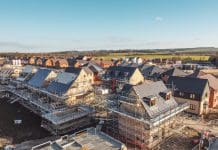The WorldGBC has launched today (26 October 2022) a new industry guide on ‘Climate Change Resilience in the Built Environment’, which illustrates effective and practical steps which can be taken to adapt and build resilience to the changing climate
The impacts of climate change affect at least 85% of the world’s population, bringing acute hazards such as droughts, rising sea levels and increasing the severity of heat waves and floods.
Climate change resilience is essential to build community capacity to survive and thrive in our built environments.
WorldGBC’s flagship Health and Wellbeing global programme ‘Better Places for People’ (BPFP), has partnered with the UN High-Level Climate Champions and C40 Cities to deliver the new industry guide on Climate Change Resilience in the Built Environment.
The guide will continue to elevate awareness of the role of the built environment in securing a resilient future
On 10 November 2022, during the Youth & Future Generations Day at the UN Climate Change Conference, COP27, and in line with ‘Resilience’ being the UN High-Level Climate Champions’ focus of the day, the guide will be showcased at a high-level event in the Buildings Pavilion of the Blue Zone.
This will continue to elevate awareness of the critical role of the built environment in securing a resilient future.
What is the aim of the guide?
The ‘Climate Change Resilience in the Built Environment’ guide presents principles of built environment management for changes to weather-related climate change impacts such as storms, high winds, droughts, floods, severe temperature change, and wildfires.
These principles are focused on measures of mitigation and damage protection from continual or gradual climate impacts and, in some cases, extreme weather events.
The impacts of climate change and damage from extreme and gradual weather events will occur at building, community and city scales across all corners of the globe.
Therefore, measures to mitigate damage and ensure recoverability must be implemented at a systemic level. To incorporate climate resilience strategies across a series of complex systems, all built environment stakeholders and decision makers must engage and take responsibility. Leadership from local and national governments is essential to activate meaningful adaptation and resilience solutions.
Resilience action is essential if we are to build the community capacity to survive and thrive
WorldGBC encourages the broad range of built environment stakeholders set out in the guide to engage with their role, to exert their influence and implement change. Under the inevitable impacts of climate change, resilience action is essential if we are to build the community capacity to survive and thrive within our built environments.
We need to listen and learn from the voices of those communities most impacted by climate impacts – to respond adequately in the delivery of resiliency solutions.
WorldGBC is grateful for the support from the BPFP Steering Committee and Sponsors, including Buro Happold, Multiplex, Saint-Gobain, and Shaw Contract.
‘Supporting the much-needed transition towards people-centric infrastructure solutions’
Cristina Gamboa, CEO, WorldGBC, commented: “In response to the ongoing impacts of our changing climate, the UN High-Level Climate Champion, C40 cities, and WorldGBC are proud to share this practical guide for Climate Change Resilience in the Built Environment in the lead up to COP27. This principle-based resource will support the much-needed transition towards people-centric infrastructure solutions considering different urban scales.
“It’s time to scale low carbon, highly resilient and equitable built environment solutions for everyone, everywhere. And it’s time for impactful policy responses from local and regional leaders, to enable this much needed transformation.”
Building resilience to climate change
Nigel Topping, UN high-level climate action champion for UK COP26, and
Dr. Mahmoud Mohieldin, UN’s High-Level Climate Action Champion for Egypt COP27, added: “The built environment sector has the opportunity to lead the resilience agenda, placing adaptation on par with mitigation through how we design, manage and occupy buildings and infrastructure for the worlds’ people.
“Regardless of where you live or where you do business, we all need to build resilience to climate change.”














